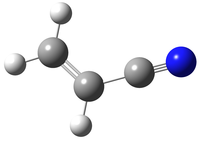|
The spectroscopic parameters and the experimental
transition frequencies were published in
(1) H. S. P. Müller, A. Belloche, K. M. Menten,
C. Comito, and P. Schilke,
2008, J. Mol. Spectrosc. 251 319.
Besides from this work, the data originate
from
(2) M. C. L. Gerry and G. Winnewisser,
1973, J. Mol. Spectrosc. 48, 1;
(3) J. Demaison, A. Bouchy, G. Roussy, and J. Barriol,
1973, Compt. Rend. 276C, 967;
(4) M. Stolze and D. H. Sutter,
1985, Z. Naturforsch. 40a, 998;
(5) G. Cazzoli and Z. Kisiel,
1988, J. Mol. Spectrosc. 130, 303;
(6) J. Demaison, J. Cosléou, R. Bocquet,
and A. G. Lesarri,
1994, J. Mol. Spectrosc. 167, 400;
(7) O. I. Baskakov, S. F. Dyubko, V. V. Ilyushin, M. N.
Efimenko, V. A. Efremov, S. V. Podnos, and E. A. Alekseev,
1996, J. Mol. Spectrosc. 179, 94;
and from
(8) J. M. Colmont, G. Wlodarczak, D. Priem, H. S. P.
Müller, E. H. Tien, R. J. Richards, and M. C. L. Gerry,
1997, J. Mol. Spectrosc. 181, 330.
Data with experimental uncertainties larger than 50 and
100 kHz have not been merged for transition frequencies
below and above 200 GHz, respectively.
Predictions with uncertainties exceeding 1 MHz by a
significant amount should be viewed with increasing caution.
14N hyperfine splitting may be resolved
for low values of J. Therefore, a
separate hyperfine calculation is provided for J' ≤ 10
and frequencies below 100 GHz.
NOTE: The partition function
does take into account the spin multiplicity
gI = 3 of the 14N nucleus !
Furthermore, energy levels up to J = 170 and
Ka = 50 have been considered in the calculation of
the partition function. This is sufficient up to 300 K.
At higher temperatures classical extrapolations are recommended.
The partition function also includes contributions from low-lying
vibrational modes. Partition function values for only
the ground vibrational state are given in parentheses.
The dipole moment was taken from (4).
|
